Musical (1978)
Music: Andrew Lloyd Webber
Lyrics: Tim Rice
Directed by Sammi Cannold
Music Director: Nona Seyed-Bolorforosh
Choreography: Emily Maltby, Valeria Solomonoff
American Repertory Theater
Loeb Drama Center
Harvard Square, Cambridge, MA
May 17- July 30, 2023
Orchestrations: David Cullen, Andrew Lloyd Webber, based on Orchestration originally by Andrew Lloyd Webber; Music Supervisor: Kristen Blodgette; Associate Music Supervisor: Michael Patrick Walker; Scenic Design: Jason Sherwood; Costume Design: Alejo Vietti; Lighting Design: Bradley King; Sound Design: Connor Wang; Hair & Wig Design: Ashley Rae Callahan
With Gabriel Burrafato (Magaldi), Omar Lopez-Cepero (Che), Shereen Pimentel (Eva), Caesar Samayoa (Peron), Naomi Serrano (Mistress, Ensemble), Sky Vaux Fuller (Child, Ensemble), Ensemble: Martin Almiron, Julian Alvarez, Marissa Barragán; Leah Barsky; Bianca Bulgarelli; Camila Cardona; Melody Celatti; Esteban Domenichini; Rebecca Eichenberger; Sean Ewing; Nicole Fernandez-Coffaro; David Michael Garry; Eddie Gutiérrez; Eric Anthony Lopez; Eric Anthony Lopez; Jonatan Lujan; Caleb Marshall-Villarreal; Ilda Mason; Jeremiah Valentino Porter; Maria Cristina Posada Slye; Leonay Shepherd; Swings: Marissa Barragán, Mathew Bautista; Isabella Lopez; Miguel Angel Vasquez; Julieta Ortiz
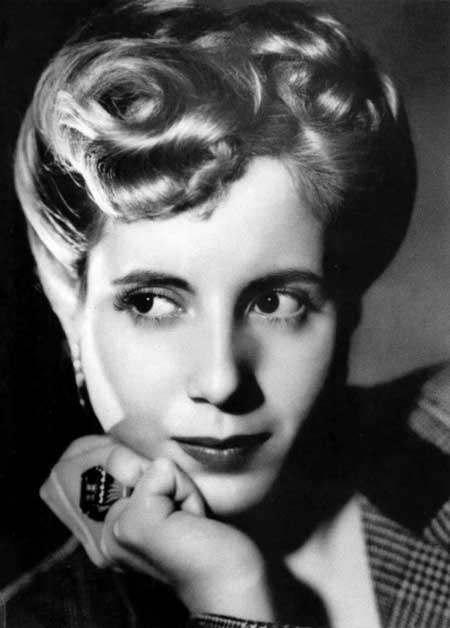
Eva Duarte Perón (1919-1952) (Shereen Pimentel) rose from poverty in rural Argentina, and, ambitious and determined, moved to Buenos Aires and pursued a career as an actress. Before long, she had become involved with future president Juan Perón (Caesar Samayoa) and married him at the age of 25. From that point until her death from cancer in 1952 at the age of 33, she was wildly popular with the Argentian public. During her life, apart from being a stylish and attractive personage, she was active in supporting workers’ and women’s rights.
The musical features the character of Che (Omar Lopez-Cepero), frequently identified in productions as Che Guevara (1929-1968), the Argentinian revolutionary, who serves as the omnipresent narrator of the story of Evita’s rise to power, and who offers a continuing ironic perspective on her wild popularity and political influence.
This exuberant and entertaining revival of the now classic Broadway hit features some terrific vocals and wonderful choreography.
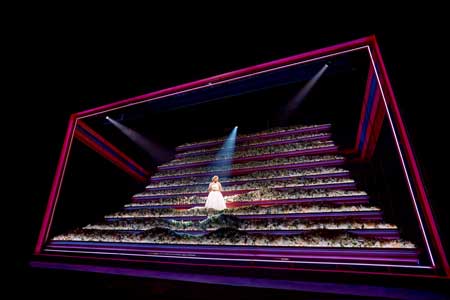
surrounded by flowers,
in “Evita”
Photo: Emilio Madrid
Courtesy of American Repertory Theater
In the title role, Shereen Pimentel has a profound contralto that shows its force throughout the demanding range the role requires. Her voice is powerful and represents something integral about the quality of character that made Eva Perón who she was and what she became. It’s a pleasure to listen to her hold forth.
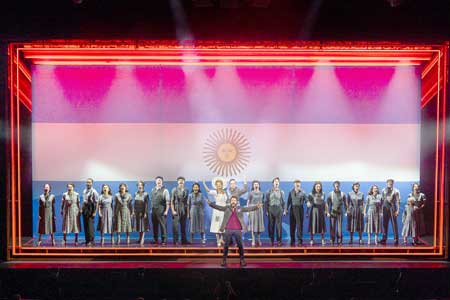
with the cast of “Evita”
Photo: Nile Scott Studio
Courtesy of American Repertory Theater
As Che, Lopez-Cepero has an equally demanding role, requiring an incredible tenor, almost countertenor, range. Mandy Patinkin held forth with a memorable treble in the original Broadway production, and here Lopez-Cepero rises notably to the occasion with a melodious and nuanced approach to those high-peaked musical lines, notable early on in Oh What a Circus and in Peron’s Latest Flame and a bit later in And The Money Kept Rolling In.
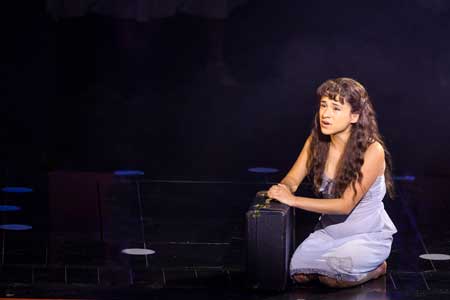
in “Evita”
Photo: Nile Scott Studio
Courtesy of American Repertory Theater
As the youthful mistress to Perón whom Evita dispenses in short order, Naomi Serrano offers Another Suitcase in Another Hall. a truly lovely solo about lost love. It is a show-stopper and makes one want to hear more; alas, it is her character’s only number. It was a real moment, reminiscent of Lauren Patten’s truly singular moment with You Oughta Know in the ART’s Jagged Little Pill (2018) which subsequently went to a run on Broadway.
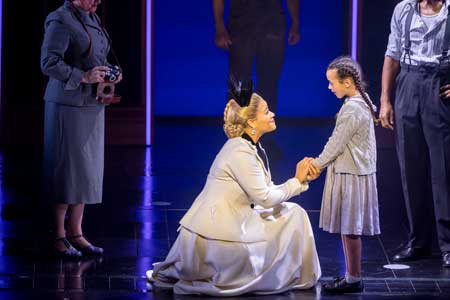
Sky Vaux Fuller as an adoring child
in “Evita”
Photo: Nile Scott Studio
Courtesy of American Repertory Theater
Another standout vocal moment is offered by Sky Vaux Fuller as a child who comes to offer appreciation and solace to Evita. Fuller is a young child, but sings Santa Evita absolutely beautifully.
As an older but elegantly attractive Perón, Caesar Samayoa provides several engagingly capable interpretations in Dice Are Rolling in its two incarnations, and She Is a Diamond, with his satisfying solos appearing particularly near the end.
In addition to these compelling vocal moments, the choreography by Emily Maltby and Valeria Solomonoff is distinctively good. There are some tremendous dancers in the ensemble – one particularly notes the contributions in dance and supporting roles by Ilda Mason – and the choreography is endlessly inventive and stimulating, constantly offering visual stimulation and excitement. It’s great to see the tango incorporated into the choreography, though at times in its longer renderings its formal grace begs for a little more sense of release and fun.
There are moments in the staging that are particularly dramatic. The show opens with a flouncy dress of the sort for which Evita was known suspended above the stage. Oddly it brings to mind the imagery of the Angel in the original Broadway production of Angels In America, but I doubt that thought entered into the conception of staging here. Perhaps the most singularly dramatic moment is during Evita’s big solo in Don’t Cry For Me Argentina when she appears in the iconic flouncy dress and the entire stage space is filled with horizonal arrays of flowers. It’s a move very much in keeping with the ART’s inclination to use its high tech facilities to the hilt, and pretty effective. A little less effective is the constant use of neon in the set design. It is an okay design choice, not too distracting though a curious one, signifying perhaps something about color, glitz, showbiz and its prevalence in the early 1950s.
Despite that the score relies very heavily on the recapitulation of its main themes, I was struck by some of the musical variety and inventiveness throughout. It anticipates some of the motifs in another iconic musical which appeared a few years later, Les Miserables (1980), with music by Claude-Michel Schönberg. The main theme Don’t Cry For Me Argentina is, though familiar, gripping and persuasive. In this production, the welcome tilt towards Hispanic authenticity gives the word “Argentina” a soft aspirated g, a bit striking to the ear since those who know the song for the past almost fifty years were raised on the English hard g; one manages.
The lyrics by Tim Rice are, well, okay. Though by now they’ve become part of theater history because of the success of Evita, they’re pretty straightforward. They do give a basic account of the story of the rise of the enigmatic Eva and the quizzical reflection upon it by the Che character. Unlike the lyrics of Lin-Manuel Miranda’s Hamilton (2016), however, which cram an entire history into the assorted rap-inspired songs in that musical, or any number of lyrics by the late Stephen Sondheim which both inform and entertain with constant wit and ebullience, Rice’s lyrics tell their story pretty well, but are more or less just kind of there. Rice does come up with some memorable lyric moments, and he did, after all, come up Don’t Cry For Me Argentina; but one feels there might be more.
The show does convey the irony of celebrity, particularly with regard to politics, clearly a contemporary issue. Though the direct relation of Che Guevara to the Peróns is not documented, the show calls up enough revolutionary criticism through the Che character to make its point. Despite Evita’s humble beginnings and the sympathy she drew from the crowds who adored her, and despite the impression of social justice that Perónisme conveyed, there was, as the character Che articulates, not much of social substance that came along with it. If the show is about the appearance and illusion of social change, and the intoxication of personality in creating that illusion, it does its job quite well. By pitting the intense ambition of Eva Perón against the projected image of her as the up-from-the-gutter saint as stateswoman, Evita represents a tragicomic reflection on what continues to pass as political authenticity.
One expects that this production, like so many mega productions launched at the ART, will wind up on Broadway and on the road. This one certainly looks that way. Lovely singing, excellent choreography, it’s certainly worth a visit while in town.
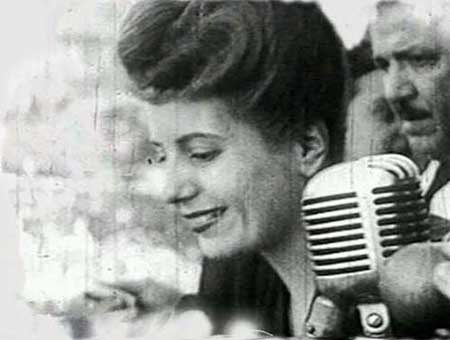
– BADMan (aka Charles Munitz)
Leave a Reply